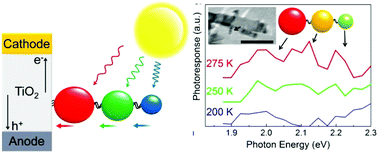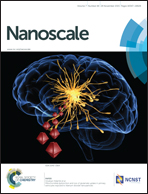Long-range energy transfer in self-assembled quantum dot-DNA cascades†
Abstract
The size-dependent energy bandgaps of semiconductor nanocrystals or quantum dots (QDs) can be utilized in converting broadband incident radiation efficiently into electric current by cascade energy transfer (ET) between layers of different sized quantum dots, followed by charge dissociation and transport in the bottom layer. Self-assembling such cascade structures with angstrom-scale spatial precision is important for building realistic devices, and DNA-based QD self-assembly can provide an important alternative. Here we show long-range Dexter energy transfer in QD-DNA self-assembled single constructs and ensemble devices. Using photoluminescence, scanning tunneling spectroscopy, current-sensing AFM measurements in single QD-DNA cascade constructs, and temperature-dependent ensemble devices using TiO2 nanotubes, we show that Dexter energy transfer, likely mediated by the exciton-shelves formed in these QD-DNA self-assembled structures, can be used for efficient transport of energy across QD-DNA thin films.


 Please wait while we load your content...
Please wait while we load your content...